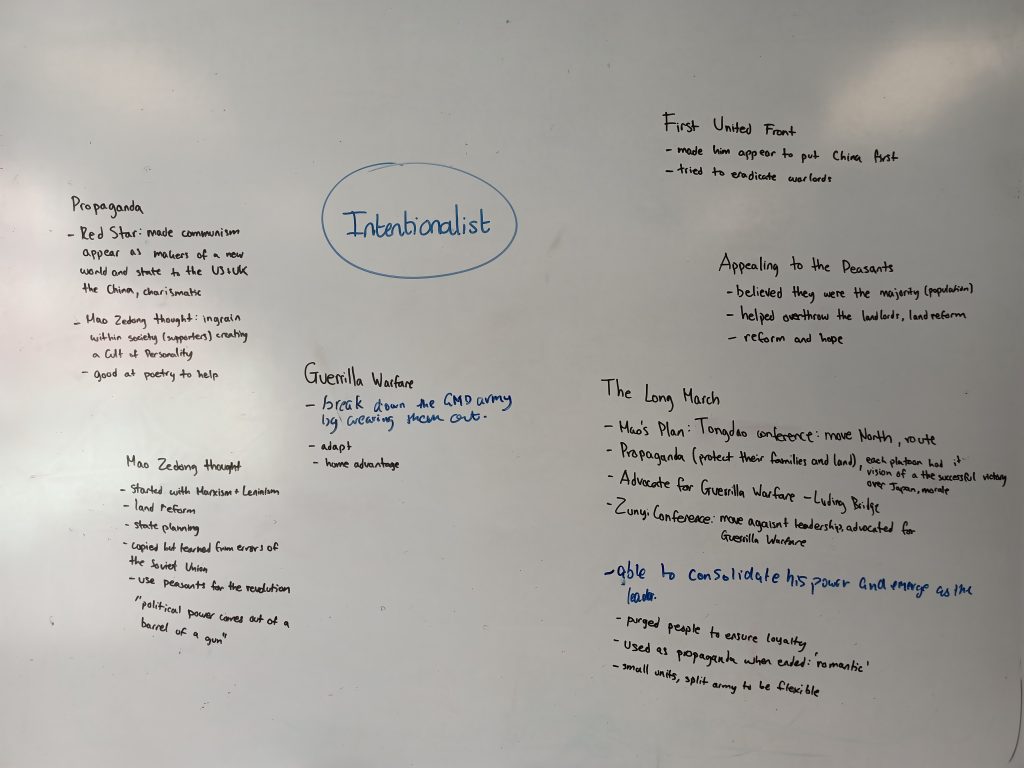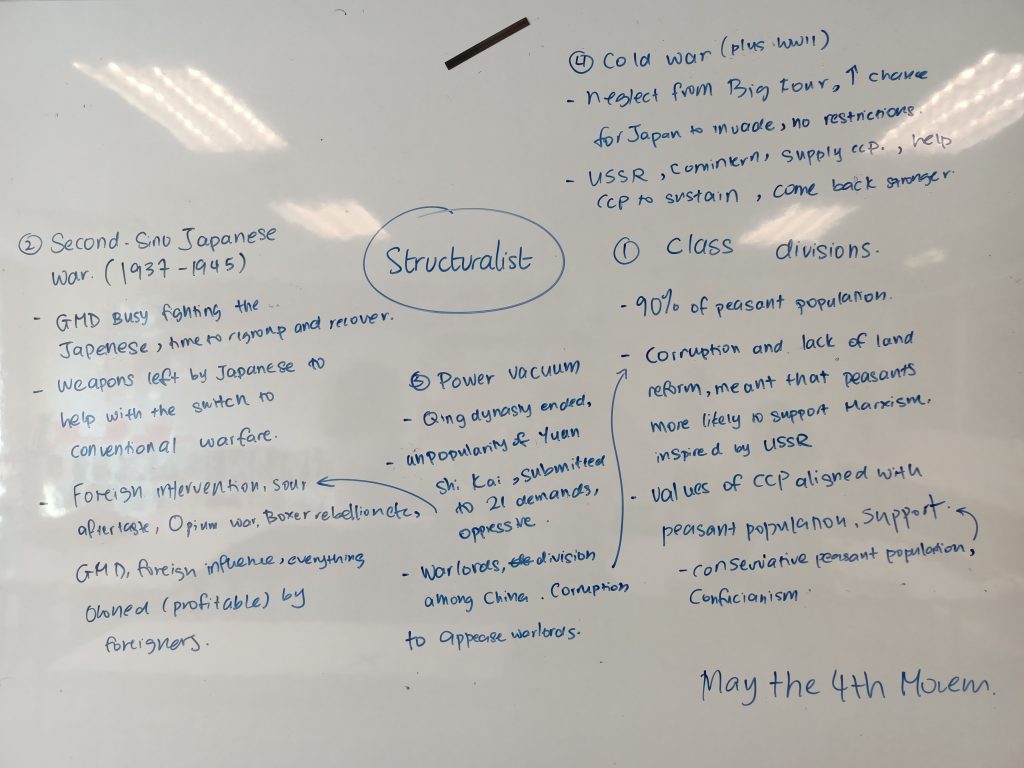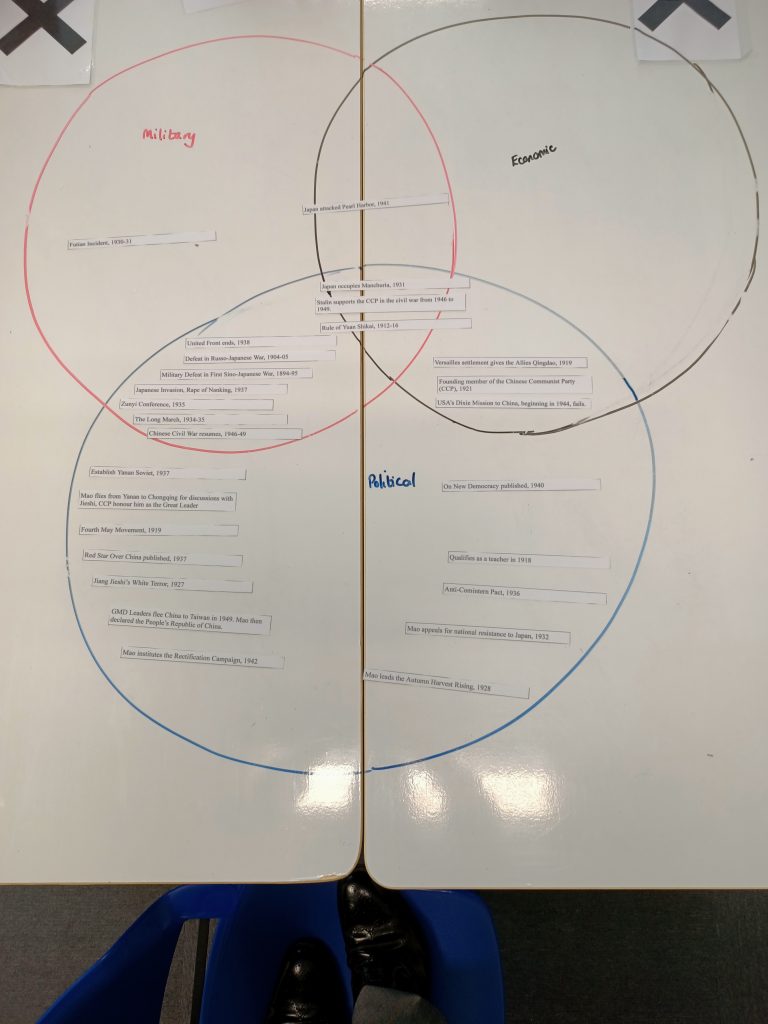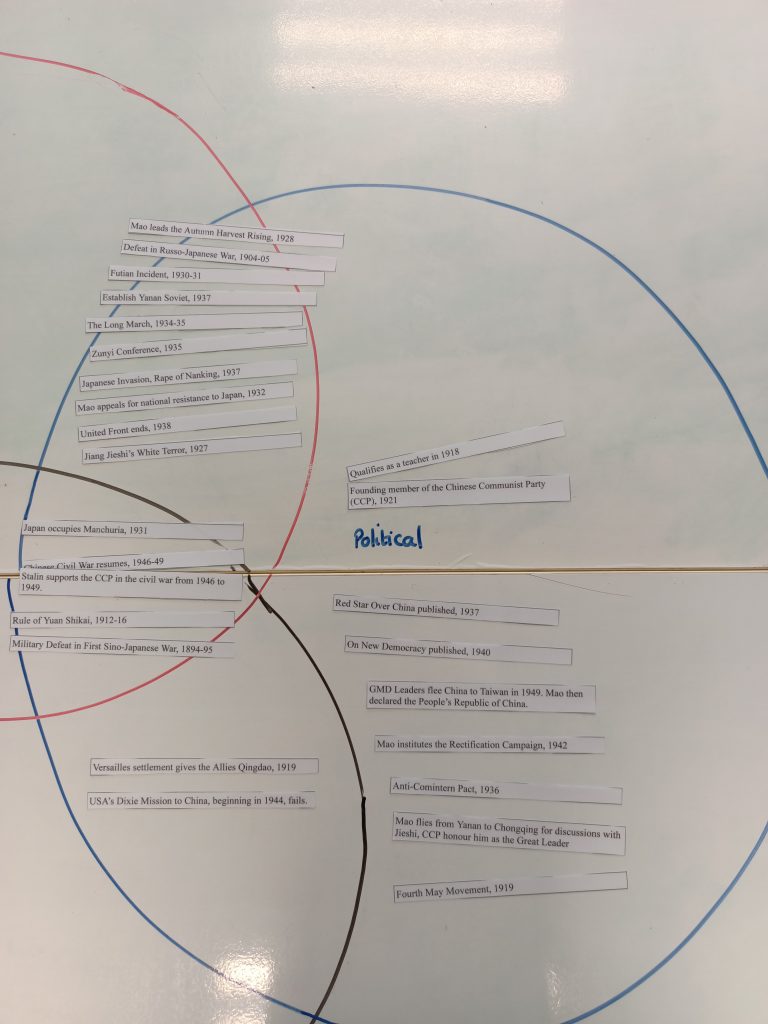- Timeline
- Political Ideology
- The Long March
- Cult of Personality
- Second World War
- Luck
- Resources
- Student Perspectives
Timeline
1921 Mao Zedong established the Changsha branch of the Chinese Communist Party.
1924 First United Front created with the GMD to fight the warlords.
1927 Jiang Jieshi ended the alliance.
1934 The Long March
1935 Zunyi Conference
1937 Invasion of China by Japan.
1945 The civil war restarts in China.
1949 Mao and the CCP win the civil war, the Peoples’ Republic of China (PRC) begins.
Political Ideology
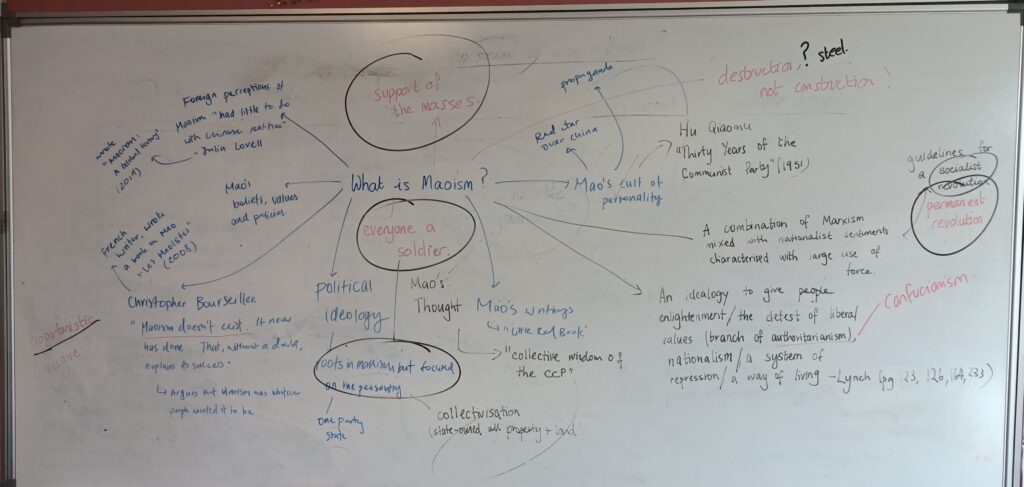
The key points from the brainstorming session above are:
- Maoism is more a western concept, Mao Tse-tung Thought is more accurate for China.
- Permanent Revolution, China needs to continuously reform to reach utopia. There is a revolution after a revolution.
- Violence is needed to achieve a successful revolution
- The masses are required to act along military lines, soldiers, and take part in an armed struggle.
- ‘tianxia‘ or ‘all under heaven’ under Maoism meant that China was superior to all others.
- The Chinese Communist Party entered a new strategic situation after the defeat of the Chinese Soviet Republic. Mao reduced the emphasis on the class struggle and economic redistribution and focused on unity and patriotism against Japan.
- Mao learned from this period that effective communication was needed between small groups (for example, CCP committees) and the mass population. No longer can the ‘Twenty-Eight Bolsheviks’ rule alone.
- The Zunyi Conference of 1935 demonstrated Mao’s belief in guerrilla warfare and how the ‘Twenty-Eight’ were out of step with the peasants.
- In the 1920s, he saw the importance of land reform and continued to promote this in the 1930s.
- According to Brantly Womack, Mao claimed that his political theories continued were consistent throughout his career. However, Womack argues that Mao deliberately made general statements about his earlier experiences so they could be interpreted to suit his present policies. He also kept statements about the relationship between Marxism and Chinese culture vague.
- Marx’s class struggle was a major contributor to Mao’s idea of revolution. It provided him with the answer to China’s, especially the peasants’, problems.
- Mao was not an opportunist but attempted to achieve attainable goals. Mobilising and gaining the support of the masses was one of these. However, the failure of the May Fourth movement led him to focus on revolutionary organisation too. It also persuaded him that the revolution would not just happen naturally, it had to be forced. Hence, his infamous quote, “political power grows out of the barrel of a gun”.
- Guerrilla warfare and the establishment of a rural base were practical solutions for Mao, not a theoretical innovation, the priority was survival in the 1930s and both of these helped to achieve this. The peasants, not the proletariat, were the driving force for Mao so a rural revolution was planned.
- After 1949, the focus changed. There was no need for survival so Mao now turned to cement his ideology. The people needed theoretical guidance. He continued to allow cadres to have independence and hold them accountable, but nationally he introduced a number of policies to promote his Communist vision and both encourage and force people to support it. See the timeline above.
- Michael Lynch explains that ‘As a Chinese revolutionary, he rejected Western values but made it his mission to match Western achievements.’ But in trying to rid the country of foreign influences, ‘he adopted a Western political theory – Marxism.'(Mao, p. 2)
- He chose this ideology because he saw its destructiveness, and he believed China had to be destroyed before being rebuilt.
- Mao read classical Chinese and Confucian history more so than Marx or Lenin. One could argue that he ruled more like a traditional emperor rather than a communist leader. For example, he sought the reverence of the people whereas Lenin criticised those who idolised him.
The Long March
From one of Mao’s speeches… (from ThinkIB)
” We say that the Long March is the first of its kind ever recorded in history, that is, it is a manifesto, an agitation corps, and a seeding machine…For twelve months we were under daily reconnaissance and bombing from the air by scores of planes; we were encircled, pursued, obstructed and intercepted on the ground by a big force of several hundred thousand men, we encountered untold difficulties and great obstacles on the way, but by keeping our two feet going, we swept across a distance of more than 20,000li (about 6.750 miles) through the length and breadth of eleven provinces. Well, has there ever been in history a long march like ours? No, never.
‘The Long March is also a manifesto, It proclaims to the world that the Red Army is an army of heroes, and that the imperialists and their jackals, Jiang Jieshi and his like, are perfect nonentities.
The Long March is also an agitation corps. It declares to approximately two hundred million people of eleven provinces that only the road of the Red Army leads to their liberation. Without the Long March, how could the broad masses have known so quickly that there are such great ideas in the world as are upheld by the Red Army?
The Long March is also a seeding-machine, it has sown many seeds in eleven provinces which will sprout, grow leaves, blossom into flowers, bear fruit and yield a crop in the future.
To sum up, the long March ended with our victory, and the enemy’s defeat .”
- The CCP and Comintern decision to adopt conventional war methods to fight the GMD in 1934 led to defeat. The previous four GMD offensives had failed against the guerrilla tactics of the Communists. This defeat led to the declining influence of Otto Braun and the Comintern, and the rise of Mao. He disagreed with the change in strategy and his foresight allowed him to distance himself from the defeat.
Cult of Personality
Notes are taken from ‘How to be a dictator – The Cult of Personality in the Twentieth Century’ by Frank Dikötter.
1924 to 1949
- Mao had been partly financed by the Soviet Comintern since he was twenty-one years of age. As such, Moscow had huge influence on how the Communist Party in China would grow. For example, in 1924 and in Mao’s home province of Hunan, Russian advisers funded peasant associations to start a revolution. They turned the society upside down, becoming the masters and taking excessive revenge on the formerly wealthy and powerful. Mao saw the violence and death and was enthralled, believing that if the associations were to become hundreds of millions, they could create a new China.
- But this belief in peasants went against the Marxist ideology whereby the proletariat rose up. Therefore, Mao had to adapt this thinking to suit China, a nation of peasants. On 7 November 1931, he proclaimed a Soviet Republic in Jiangxi. It was financed by Moscow and introduced its own currency, stamps, etc. However, the Central Committee stripped him of his command because they were critical of his guerrilla warfare methods. Zhou Enlai became the leader but was defeated by the Kuomintang in 1934. This led to the Long March, Mao leading the remaining forces to Yan’an and safety (it was a mountainous region and difficult for their enemies to reach). This march was to prove important for decades, Mao using it as proof of his theory that he was destined to take power and lead China forward.
- In 1935, the Soviet Union poured huge praise on Mao labelling him as ‘vozhd’ or great leader; only Lenin and Stalin were called this at the time. Mao decided to build on this announcement to cement his position as leader of the Communist Party. He needed to deter rivals and create a belief in his skills to lead China. Mao employed a young US reporter Edgar Snow and talked about his mythical youth and career as a revolutionary. The consequent book ‘Red Star over China’ was published in 1937 and became an immediate success. He was ‘an accomplished scholar of classical Chinese, an omnivorous reader, a deep student of philosophy and history, a good speaker, a man with an unusual memory and extraordinary powers of concentration, an able writer…and political strategist of considerable genius.’ Mao had also come from the very bottom of Chinese society and it was his destiny to regenerate his country.
- ‘On New Democracy’ was also written in 1940 during the war against Japan. It was a pamphlet aimed at all revolutionary classes, explaining the democratic virtues of the Communist Party. It was all fiction but brought more support and attracted thousands of students, teachers, artists, writers and journalists to Yan’an. However, Mao was suspicious of this intelligentsia, preferring loyalty rather than free-thinking. Consequently, in 1942 he launched the Rectification Campaign – this intimidated the whole party to ensure absolute loyalty (and rid the party of Soviet influence too). More than 15 000 ‘enemy agents and spies’ were identified, being tortured, imprisoned or even executed. Importantly for Mao, he gave the task of implementing the Rectification Campaign to Kang Shek. Once over, he was blamed for the excessive violence, leaving Mao as the benevolent leader.
- Mao also set up a Central General Study Committee, full of loyal allies such as Liu Shaoqi. They controlled everything in Yan’an and ensured everybody was loyal to Mao. This included rivals swearing loyalty, even being humiliated to prove this. Zhou Enlai was one example, after which he became Mao’s loyal servant for decades to come. Importantly, unlike Stalin, rivals were rarely shot – they would work tirelessly to prove their ‘renewed’ loyalty.
- From this period onwards, the Cult of Personality intensified. Mao was revered as a virtual deity and all had to acknowledge his genius and benevolence to the Chinese people. Portraits, badges and songs would spread these messages across Yan’an and China. In April 1945, Liu Shaoqi called Mao ‘the greatest theoretician and scientist in all of Chinese history‘.
Second World War
Take one article each and answer the questions below.
https://foreignpolicy.com/2015/09/03/china-lost-world-war-2-china-world-war-ii-victory-parade/
https://psmag.com/news/china-lost-14-million-people-world-war-ii-forgotten-66482
https://www.nytimes.com/2013/10/18/opinion/the-worlds-wartime-debt-to-china.html
- What role did China have in defeating the Japanese in the Second World War?
- What role did the CCP have in defeating the Japanese in the Second World War?
- Is there a debate over this role? If so, why?
Luck
- In 1936, Chiang Kai-shek was kidnapped and forced to fight the Japanese rather than the communists.
- Japan invaded in 1937 and the GMD bore the brunt of the fighting which ensued. The CCP was in relative safety in rural areas in the meantime.
- The USSR was in a position to help the Chinese communists after Japan left the country in 1945. This aid allowed the Red Army to evolve from one which fought using guerrilla tactics to one which could fight conventional battles.
Resources
Student Perspectives
